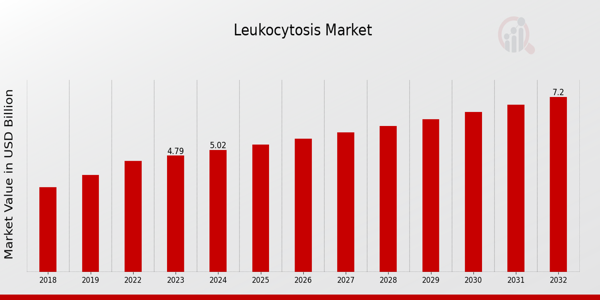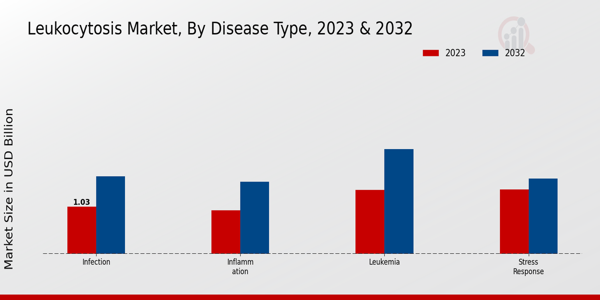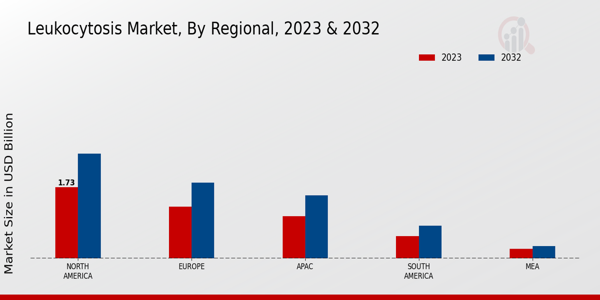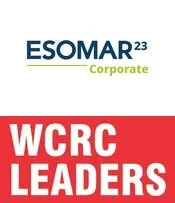Global Leukocytosis Market Overview
As per MRFR analysis, the Leukocytosis Market Size was estimated at 5.25 (USD Billion) in 2024. The Leukocytosis Market Industry is expected to grow from 5.49 (USD Billion) in 2025 to 8.25 (USD Billion) till 2034, at a CAGR (growth rate) is expected to be around 4.63% during the forecast period (2025 - 2034).
Key Leukocytosis Market Trends Highlighted
The Leukocytosis Market is influenced by several key market drivers, including the rising prevalence of infections and inflammatory diseases, which has heightened the need for accurate diagnostic solutions. The advancements in laboratory technologies and the increasing awareness among healthcare professionals about the importance of early diagnosis further propel this market. Moreover, the growing geriatric population and more frequent health check-ups contribute to the increasing demand for leukocytosis-related tests and treatments. There is also a noticeable shift towards personalized medicine, where therapies are tailored to the individual patient's condition, nurturing growth in this market segment.Opportunities are abundant within the Leukocytosis Market, especially with the development of novel diagnostic tools and therapies that can improve patient outcomes. Collaboration between pharmaceutical companies and diagnostic firms could lead to innovative treatment options and better diagnostic techniques. Emerging markets where healthcare infrastructure is evolving present significant growth potential for key players. Companies focusing on research and development may exploit gaps in treatment and diagnostics, ultimately leading to enhanced management of leukocytosis. Recent times have seen trends toward digital and remote health solutions, driven by the increasing acceptance of telemedicine.This shift allows for quicker diagnosis and treatment, reaching patients in remote areas. Additionally, the integration of artificial intelligence in diagnostic tools is gaining traction, enabling more precise assessments and timely interventions. The rise of value-based care is reshaping how treatments are delivered and reimbursed, impacting the overall approach to managing leukocytosis. These trends point toward a future where technology plays an essential role in streamlining processes and improving patient care in the Leukocytosis Market.

Source: Primary Research, Secondary Research, MRFR Database and Analyst Review
Leukocytosis Market Drivers
Growing Incidence of Chronic Diseases
The Leukocytosis Market Industry is significantly driven by the rising prevalence of chronic diseases, including cancer, autoimmune disorders, and infections. As the global population ages and lifestyle-related diseases become more common, the demand for effective diagnostic and therapeutic options rises, leading to increased scrutiny of leukocyte levels. Chronic diseases often result in elevated white blood cell counts, prompting further investigation and treatment, which propels the leukocytosis market forward.Furthermore, advancements in medical technologies and diagnostic methods facilitate earlier detection and management of these conditions, allowing for targeted treatments and improved patient outcomes. The integration of precision medicine and personalized treatment approaches enhances the market as healthcare professionals increasingly focus on individualized care strategies based on leukocyte count and other biomarkers. Increased awareness surrounding blood-related disorders has also contributed significantly to market growth, as patients and healthcare providers seek better understanding and management of leukocytosis.As research continues to develop, new therapeutic agents and diagnostics are expected to be introduced, further stimulating the Leukocytosis Market Industry and leading to better handling of associated health issues.
Advancements in Diagnostic Technologies
Technological innovations in diagnostic tools and methods have emerged as a notable driver for the Leukocytosis Market Industry. Enhanced imaging and laboratory techniques, including flow cytometry, automated cell counters, and molecular diagnostics, have revolutionized the capacity to accurately measure and analyze leukocyte counts. These advancements not only increase the precision of diagnosis but also ensure quicker turnaround times, thereby supporting timely treatment decisions.As diagnostic methodologies continue to evolve, healthcare providers can better identify leukocytosis and its underlying causes, which in turn stimulates the demand for related healthcare services, influencing market growth positively.
Increase in Health Awareness Programs
The rising trend of health awareness programs globally is significantly impacting the Leukocytosis Market Industry. As individuals become increasingly educated about health and wellness, they are more likely to proactively seek medical consultations and screenings, including comprehensive blood tests that assess leukocyte levels. Educational campaigns led by government bodies and non-profit organizations aim to improve public understanding of hypertension, chronic diseases, and their associated risks, leading to increased healthcare engagement.This heightened awareness directly correlates with increased diagnosis and treatment of leukocytosis, driving growth in the market for related products and services and ultimately fostering better patient outcomes.
Leukocytosis Market Segment Insights:
Leukocytosis Market Disease Type Insights
The Leukocytosis Market is an evolving sector with anticipated market values driving growth within various Disease Types that contribute significantly to its overall valuation. As of 2023, the market is valued at 4.79 USD Billion, reflecting diverse influences from several disease categories, including Infection, Inflammation, Leukemia, and Stress Response. The Infection segment of the market, valued at 1.034 USD Billion in 2023, is expected to grow to 1.692 USD Billion by 2032, showcasing a robust demand primarily influenced by rising infectious diseases and the need for continued advancements in diagnostics and therapeutics.Inflammation, with a valuation of 0.951 USD Billion in 2023, is projected to reach 1.575 USD Billion by 2032, indicating an increasing recognition of chronic inflammation's role in various health conditions, extending the understanding of its implications on leukocytosis. The Leukemia segment, representing a significant portion of the market at 1.398 USD Billion in 2023, is anticipated to surge to 2.286 USD Billion by 2032. This dominance is influenced by increasing incidence rates and improved treatment protocols, alongside heightened awareness of blood cancers.Stress Response, valued at 1.406 USD Billion in 2023, is also noteworthy as it reflects the impact of physiological stress on immune response, with its projected valuation of 1.647 USD Billion by 2032 suggesting an important intersection between stress management and leukocyte count fluctuations. Each of these disease categories plays a crucial role in driving the overall market dynamics of the Leukocytosis Market, showcasing trends that emphasize not only the need for continued medical research but also the potential for innovation in treatment strategies.The segmentation within the market underscores a multifaceted landscape influenced by diverse health challenges, where factors such as increasing healthcare expenditure, rising awareness about blood disorders, and the growing prevalence of infectious diseases further amplify the urgency for research and development within each category. The ability of the Leukocytosis Market to address these pressing health matters highlights the substantial opportunities that exist for stakeholders across the medical and pharmaceutical industries, paving the way for advancements that could significantly alter patient outcomes related to these diseases.The statistics surrounding these disease types illustrate the potential for growth and the importance of targeting specific health challenges that are contributing to the expanding market in leukocytosis research and treatment.

Source: Primary Research, Secondary Research, MRFR Database and Analyst Review
Leukocytosis Market Diagnosis Type Insights
The Leukocytosis Market revenue is projected to be valued at 4.79 USD Billion in 2023 and is expected to grow to 7.2 USD Billion by 2032, showing significant potential in the Diagnosis Type segment. Within this market, various diagnostic methods play a crucial role in identifying and managing leukocytosis effectively. Blood tests hold substantial importance as they provide initial insight into white blood cell counts, enabling prompt decision-making in clinical settings. Bone marrow biopsy serves as a critical procedure for detailed analysis, particularly when exploring underlying conditions that contribute to abnormal leukocyte levels, making it significant in further diagnosing complex cases.Imaging techniques, while used less frequently, supplement diagnosis by offering visual confirmation of abnormalities related to leukocyte overproduction. The combination of these diagnostic approaches is vital for accurate and timely assessments, responding to the increasing prevalence of leukocytosis and its associated conditions. The Leukocytosis Market statistics showcase the interconnected growth drivers including advancements in diagnostic technologies and increasing health awareness. However, challenges such as the high cost of procedures and the need for skilled professionals in conducting certain tests remain areas of focus.The overall demand for effective diagnosis presents numerous opportunities for innovation and growth within the Leukocytosis Market industry.
Leukocytosis Market Distribution Channel Insights
The Leukocytosis Market has shown considerable evolution in its Distribution Channel segment, which plays a pivotal role in enhancing accessibility for patients. As of 2023, the overall market was valued at 4.79 billion USD, reflecting a steady growth trajectory. The market consists of various distribution methods, with Hospital Pharmacies, Online Pharmacies, and Retail Pharmacies being prominent participants. Hospital Pharmacies often dominate sales due to their convenience for inpatients and complex therapeutic needs, making them a critical access point for medications related to leukocytosis.Online Pharmacies are also gaining traction as they provide patients with ease of access and convenience, especially in regions where healthcare facilities are sparse. Meanwhile, Retail Pharmacies serve as an essential link to everyday consumers, often being the first point of dispensing for over-the-counter and prescription medications. The collective impact of these distribution channels reflects the varied preferences of health professionals and patients, demonstrating the importance of versatile access routes in the Leukocytosis Market industry.The ongoing trends and continual innovation in distribution methods are expected to present new opportunities for market growth in the coming years.
Leukocytosis Market End User Insights
The Leukocytosis Market revenue reflects a diversified landscape focused on various end users, including hospitals, diagnostic laboratories, and research institutions. In 2023, the market was valued at 4.79 billion USD, showcasing significant financial investment across these sectors. Hospitals play a crucial role in this space, as they are often the primary point of care for patients experiencing symptoms associated with leukocytosis, leading to substantial service demand. Diagnostic laboratories also hold a significant place, providing essential testing services that support disease diagnosis and monitoring.Moreover, research institutions contribute to advancing knowledge by conducting studies that explore the underlying mechanisms of leukocytosis, enabling potential new treatment avenues. As the Leukocytosis Market industry evolves, trends such as increased prevalence of chronic diseases, rising healthcare expenditure, and advancements in diagnostic technologies act as growth drivers. However, challenges like the high costs of certain diagnostic procedures and the necessity for trained personnel may influence growth dynamics. Overall, the Leukocytosis Market statistics underscore the necessity for effective collaboration among these end users to enhance patient care and outcomes.
Leukocytosis Market Regional Insights
The Leukocytosis Market is witnessing significant activities across various regions, with a total market valuation of 4.79 USD Billion in 2023. North America accounts for a majority holding, valued at 1.73 USD Billion in 2023 and projected to grow to 2.54 USD Billion by 2032, driven by advanced healthcare infrastructure and increasing prevalence of chronic diseases. Europe follows with a value of 1.25 USD Billion in 2023 and is expected to reach 1.84 USD Billion by 2032, showcasing robust research and development initiatives within the region.The APAC region holds a valuation of 1.03 USD Billion in 2023, presenting opportunities for growth due to an increase in awareness and accessibility of healthcare services, expected to be 1.53 USD Billion by 2032. South America, with a valuation of 0.54 USD Billion in 2023 and a growth to 0.79 USD Billion by 2032, remains relatively smaller but is improving due to evolving healthcare policies and market entry of new therapies. Meanwhile, the MEA region, valued at 0.24 USD Billion in 2023, demonstrates gradual growth potential as healthcare conditions improve and access to treatments becomes more common.The diversity in the Leukocytosis Market segmentation affords ample opportunities for stakeholders to leverage regional strengths and address varying healthcare needs.

Source: Primary Research, Secondary Research, MRFR Database and Analyst Review
Leukocytosis Market Key Players and Competitive Insights:
The Leukocytosis Market is characterized by a diverse landscape driven by the increasing prevalence of conditions that lead to elevated white blood cell counts. As the demand for effective diagnostic and therapeutic solutions grows, numerous companies are striving to enhance their product offerings and establish a significant market presence. The competitive dynamics of this market are shaped by various factors, including innovation in laboratory diagnostics, advancements in targeted therapies, and collaborations between biopharmaceutical companies and healthcare providers. The evolving regulatory environment is also influencing market trajectories as companies aim to adhere to stringent approval processes while pushing for rapid product development. As key players navigate the complexities of the market, they must also capitalize on emerging technologies to meet the growing healthcare needs associated with leukocytosis.Roche stands out in the Leukocytosis Market due to its robust portfolio of diagnostic and therapeutic solutions. The company's unwavering commitment to research and development enables it to produce cutting-edge diagnostic platforms that identify and monitor leukocytosis effectively. Roche’s strength lies in its advanced technologies, such as automated laboratory systems that streamline the testing process, ensuring precision and efficiency in diagnosis. Additionally, the company's strong global reach allows it to cater to healthcare providers across various settings, further enhancing its market presence. By maintaining collaborations with research institutions and investing in innovative treatments, Roche has positioned itself as a frontrunner in addressing the clinical challenges associated with leukocytosis. Its emphasis on continuous improvement and personalized medicine further solidifies its role in shaping the future of this market segment.Pfizer is another key player in the Leukocytosis Market, leveraging its extensive portfolio of pharmaceuticals to address conditions that may lead to increased white blood cell counts. The company is recognized for its research-driven approach to developing therapies targeting underlying causes of leukocytosis, particularly in the context of oncological and inflammatory disorders. Pfizer’s strong emphasis on clinical trials and collaboration with healthcare professionals positions it favorably within the market. Additionally, the company benefits from its established brand reputation and a history of successful product launches, enabling it to penetrate various global markets with effective treatment options. Pfizer’s commitment to addressing unmet medical needs through innovation in drug development is evident in its strategic initiatives aimed at enhancing patient outcomes and expanding therapeutic options in the realm of leukocytosis management.
Key Companies in the Leukocytosis Market Include:
- Roche
- Pfizer
- Bristol-Myers Squibb
- Eli Lilly
- Celgene
- Johnson and Johnson
- GlaxoSmithKline
- AstraZeneca
- Amgen
- Merck
- Gilead Sciences
- AbbVie
- Takeda Pharmaceutical
- Novartis
- Sanofi
Leukocytosis Market Industry Developments
Recent developments in the Leukocytosis Market indicate significant advancements in both treatment options and market dynamics. Companies such as Roche, Pfizer, and Bristol-Myers Squibb are actively engaging in research and development to enhance therapeutic efficacy for conditions associated with leukocytosis. Eli Lilly and Celgene are also focusing on innovative drug formulations, which have led to an increasing interest from healthcare professionals and patients. Meanwhile, Johnson & Johnson and GlaxoSmithKline have been expanding their presence by enhancing partnerships and collaborations aimed at better understanding the disease mechanisms involved in leukocytosis.In terms of mergers and acquisitions, the market has seen notable activities, particularly with AstraZeneca and Amgen, pursuing strategic alliances to bolster their portfolios in hematological malignancies linked to leukocytosis. Also, Merck and Gilead Sciences have made moves to enhance their competitive edge through targeted acquisitions of smaller biotech firms specializing in blood disorders. The market valuation for companies in this space is rising as new therapies gain regulatory approvals, fostering growth and further investment that could reshape the treatment landscape for leukocytosis in the near future.
Leukocytosis Market Segmentation Insights
Leukocytosis Market Disease Type Outlook
- Infection
- Inflammation
- Leukemia
- Stress Response
Leukocytosis Market Diagnosis Type Outlook
- Blood Tests
- Bone Marrow Biopsy
- Imaging Techniques
Leukocytosis Market Distribution Channel Outlook
- Hospital Pharmacies
- Online Pharmacies
- Retail Pharmacies
Leukocytosis Market End User Outlook
- Hospitals
- Diagnostic Laboratories
- Research Institutions
Leukocytosis Market Regional Outlook
- North America
- Europe
- South America
- Asia Pacific
- Middle East and Africa
| Report Attribute/Metric |
Details |
|
Market Size 2024
|
5.25 (USD Billion)
|
|
Market Size 2025
|
5.49 (USD Billion)
|
|
Market Size 2034
|
8.25 (USD Billion)
|
|
Compound Annual Growth Rate (CAGR)
|
4.63 % (2025 - 2034)
|
|
Report Coverage
|
Revenue Forecast, Competitive Landscape, Growth Factors, and Trends
|
|
Base Year
|
2024
|
|
Market Forecast Period
|
2025 - 2034
|
|
Historical Data
|
2020 - 2024
|
| Market Forecast Units |
USD Billion |
| Key Companies Profiled |
Roche, Pfizer, Bristol-Myers Squibb, Eli Lilly, Celgene, Johnson and Johnson, GlaxoSmithKline, AstraZeneca, Amgen, Merck, Gilead Sciences, AbbVie, Takeda Pharmaceutical, Novartis, Sanofi |
| Segments Covered |
Disease Type, Diagnosis Type, Distribution Channel, End User, Regional |
| Key Market Opportunities |
Rising prevalence of related infections, Advances in diagnostic technologies, Growing demand for targeted therapies, Increased funding for research initiatives, Expansion in emerging markets |
| Key Market Dynamics |
Rising prevalence of chronic diseases, Increasing awareness and diagnosis, Advancements in diagnostic technologies, Growth in geriatric population, Expanding healthcare expenditure |
| Countries Covered |
North America, Europe, APAC, South America, MEA |
Frequently Asked Questions (FAQ) :
The Leukocytosis Market is expected to be valued at 8.25 USD Billion by 2034.
In 2023, the Leukocytosis Market is valued at 4.79 USD Billion.
The expected CAGR for the Leukocytosis Market from 2025 to 2034 is 4.63%.
North America is expected to hold the largest market share, projected at 2.54 USD Billion by 2032.
The Leukemia segment is expected to be valued at 2.286 USD Billion in 2032.
The Inflammation segment is anticipated to be valued at 1.575 USD Billion in 2032.
Major players include Roche, Pfizer, Bristol-Myers Squibb, Eli Lilly, and Johnson and Johnson.
The Stress Response segment is projected to be valued at 1.647 USD Billion by 2032.
The Asia-Pacific region is expected to reach a market value of 1.53 USD Billion by 2032.
The Infection segment is expected to be valued at 1.692 USD Billion in 2032.
























